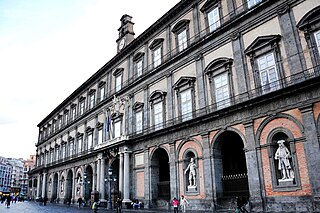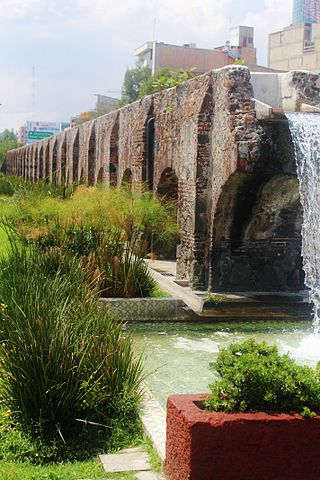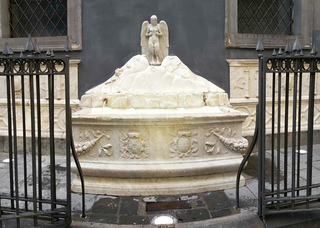
L'Aquila is a city and comune in central Italy. It is the capital city of both the Abruzzo region and of the Province of L'Aquila. As of 2023, it has a population of 69,558 inhabitants. Laid out within medieval walls on a hill in the wide valley of the Aterno river, it is surrounded by the Apennine Mountains, with the Gran Sasso d'Italia to the north-east.

Pedro Álvarez de Toledo y Zúñiga was a Spanish politician. The first effective Spanish viceroy of Naples, in 1532–1552, he was responsible for considerable social, economic and urban improval in the city and southern Italian kingdom in general. He was the father-in-law of Cosimo I de' Medici, Grand Duke of Tuscany.

Pedro Henriquez d'Azevedo y Alvarez de Toledo, Count of Fuentes de Valdepero was a Spanish general and statesman.
The Neapolitan Republic was a republic created in the Kingdom of Naples, which lasted from October 22, 1647, to April 5, 1648. It began after the successful revolt led by Masaniello and Giulio Genoino against King Philip III and his viceroys.

The Royal Palace of Naples is a palace, museum, and historical tourist destination located in central Naples, southern Italy.

Sant'Anna dei Lombardi,, and also known as Santa Maria di Monte Oliveto, is an ancient church and convent located in piazza Monteoliveto in central Naples, Italy. Across Monteoliveto street from the Fountain in the square is the Renaissance palace of Orsini di Gravina.

The State of the Presidi was a small territory on the Tuscan coast of Italy that existed between 1557 and 1801. It consisted of remnants of the former Republic of Siena—the five towns of Porto Ercole and Porto Santo Stefano on the promontory of Monte Argentario, as well as Orbetello, Talamone and Ansedonia—and their hinterland, along with the islet of Giannutri and the fortress of Porto Longone on the island of Elba.

Chiaia is an affluent neighbourhood on the seafront in Naples, Italy, bounded by Piazza Vittoria on the east and Mergellina on the west. Chiaia is one of the wealthiest districts in Naples, and many luxury brands have shops on its main street. It is also home to a business school and a medical school, as well as other public schools.

Santa Caterina a Formiello is a church in Naples, in southern Italy, located at the extreme eastern end of the old historic center of the city, on Via Carbonara and Piazza Enrico de Nicola, near the gate called Porta Capuana. The term Formiello comes from the forms or containers for water spouts found in the convent. Diagonally across the street and South is the Fontana del Formiello against the rear wall of the imposing Castel Capuano.
La Algaba is a Spanish municipality in the province of Seville, Andalusia, with a population of around 16,000. It is part of the region of La Vega and is located 11 km from the province's capital, Seville. The town dates back to the Byzantine Empire and has many historical artifacts and significant churches.

The Chapultepec aqueduct was built to provide potable water to Tenochtitlan, now known as Mexico City. Tenochtitlan was the capital of the Triple Aztec Alliance empire. This fresh water was transported from the Chapultepec springs. Two aqueducts following the same route from the springs were built by the Aztecs during the 15th century, the first destroyed by flooding and the second by the Spanish. After the Spanish conquest a colonial aqueduct was built, the ruins of which are located near Metro Sevilla.

The historic center, or Centro Storico, of Naples, Italy represents the historic nucleus of the city, spanning 27 centuries.

The Fontana del Gigante or Fountain of the Giant is a 17th-century fountain monument in Naples.

The Fountain of Neptune is a monumental fountain, located in Municipio square, in Naples, Italy. The fountain until the end of 2014 was located across the street of via Medina across from the church of Santa Maria Incoronata, Naples and a few doors south of the church complex of Pieta di Turchini. Now the fountain is located in front of the Town hill building, its location changed due to the construction of the new underground station.

The Fontana del Sebeto is a monumental fountain located in largo Sermoneta in the zone of Mergellina of Naples, Italy.

The Fountain of the Spinacorona,, vulgarly known as the Fontana delle Zizze, is an ancient fountain in central Naples, located against a wall of the church of Santa Caterina della Spina Corona.
The Fountain of Monteoliveto is a late-Baroque monumental fountain in central Naples, Italy. It is also called the Fountain of Charles II or of the Small King .

The Ponte della Maddalena was a bridge on the south east of Naples, Italy, spanning over what was once the River Sebeto, and now reflected by the path of the Via Marinella. For centuries it was one of the entry points into Naples from the South, but was obliterated during the late 19th-century urban renewal of the city.

The Praetorian Fountain is a monumental fountain located in Piazza Pretoria in the historic center of Palermo, region of Sicily, Italy. The fountain dominates the piazza on the west flank of the church of Santa Caterina, and is one block south of the intersection of the Quattro Canti. The fountain was originally built in 1544 in Florence by Francesco Camilliani, but was sold, transferred, and reassembled in Palermo in 1574.

















